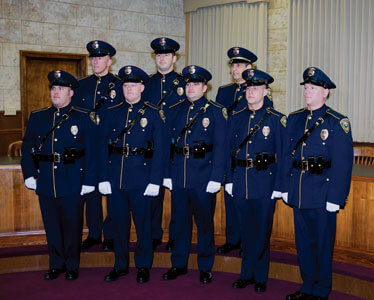Imagine that seven feet of water poured into a place of business. Imagine waiting 11 days for that water to recede. Imagine the destruction it leaves behind.
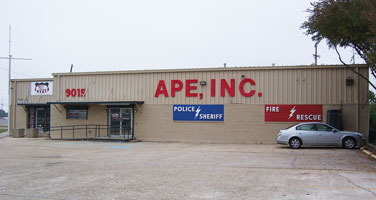 Charlie Hewlett and Belinda Comboy lived through that horror. They could’ve made a choice to pack up and run. They didn’t.
Charlie Hewlett and Belinda Comboy lived through that horror. They could’ve made a choice to pack up and run. They didn’t.
They stayed. They cleaned up. They rebuilt.
There are so many stories that came out of Hurricane Katrina’s wrath. Some were stories of people losing everything. Many were stories of people quitting. The story of A.P.E. Inc. is one of people staying put and fighting to preserve the years of hard work and knowledge that had helped build a business and make it thrive in the first place.
Hewlett began A.P.E. under the name American Police Equipment in 1986. He had been a 20 percent stockholder in an equipment firearms business since 1977 when he left to go out on his own. If there’s any question of what his talents meant to his previous company, just know that it closed its doors 45 days after he left.
American Police Equipment became A.P.E. in 1999 in an effort to streamline the name and prepare for an internet presence, but the former company remains as landlord and manager of property and hard goods.
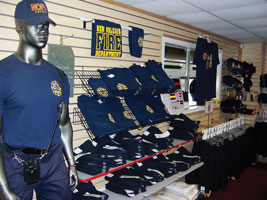 Borrowing money from his ex-wife, Hewlett began the company in a small storefront with $25,000 worth of merchandise in about 900 square feet of space. As he describes the many spaces the company has occupied since then, it quickly becomes a tangled mess of geography lessons, parish names and mixed up addresses. It’s a taste of the unique, non-linear way of doing things that New Orleans is so famous for. In 2001, the store landed in its current location at 9015 Airline Highway. The current store boasts 5,000 square feet and an abundance of stock.
Borrowing money from his ex-wife, Hewlett began the company in a small storefront with $25,000 worth of merchandise in about 900 square feet of space. As he describes the many spaces the company has occupied since then, it quickly becomes a tangled mess of geography lessons, parish names and mixed up addresses. It’s a taste of the unique, non-linear way of doing things that New Orleans is so famous for. In 2001, the store landed in its current location at 9015 Airline Highway. The current store boasts 5,000 square feet and an abundance of stock.
One look at the handy store camera on A.P.E.’s website and it’s clear that sizes and selections are plentiful. Comboy enjoys the hands-on approach to merchandising, wanting her customers to be able to find and feel the product with ease. Floor help is always available from one of the seven employees in addition to Hewlett and Comboy. Police departments, fire departments, sheriff’s departments, EMS and security personnel will find everything they need from head to toe.
Comboy says with pride, “We have $700,000 worth of inventory. We can get you in at 9 this morning, and before 3 we’ll have you in full uniform and ready to go to work.”
While Hewlett and Comboy see great use for the web, they feel there’s no substitute for being able to shop in person. That is why they’re so determined to keep providing superior in-store service, even as they embrace their online presence.
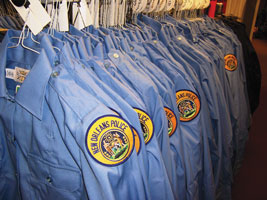 “We strive to provide the customer service that you can’t get online. And we really do take care of these people. They have so many needs,” says Comboy. She goes on to describe the many pieces and parts that go into a uniform. “It’s not just a shirt and pants. You have collar brass, epaulets, ties, hats, boots, outerwear, raincoats. Within each department you’ll have multiple divisions and assignments with further specific requirements. To be able to come here and get basically everything that they need, I think, is a great service that we provide.”
“We strive to provide the customer service that you can’t get online. And we really do take care of these people. They have so many needs,” says Comboy. She goes on to describe the many pieces and parts that go into a uniform. “It’s not just a shirt and pants. You have collar brass, epaulets, ties, hats, boots, outerwear, raincoats. Within each department you’ll have multiple divisions and assignments with further specific requirements. To be able to come here and get basically everything that they need, I think, is a great service that we provide.”
It’s amazing to think that today A.P.E. can be such a vast resource for the approximately 4,500 public safety officers in and around the city of New Orleans when on Monday, Aug. 29, 2005, it was completely washed away by the aftermath of Katrina.
While Hewlett and Comboy prepared for the storm by boarding up windows and putting computers up on higher desks, no one could predict the extent of the damage coming.
“We really waited until the very last minute – I mean like the last minute – before we decided to go,” Comboy says. She puts this in perspective by explaining that between her 85-year-old dad, 65-year-old Hewlett, and herself, no one had ever evacuated in their lifetime. Never.
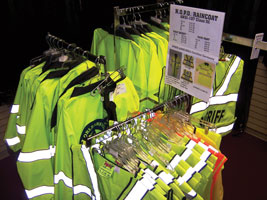 She was more concerned with the inevitable loss of electricity than anything else. Ultimately the three of them finally did travel to a friend’s house in Monroe, La., to wait out the storm. Once in Monroe, Hewlett stayed for three weeks while Comboy returned to New Orleans as soon as officials would allow anyone back into the parish, which was about a week later.
She was more concerned with the inevitable loss of electricity than anything else. Ultimately the three of them finally did travel to a friend’s house in Monroe, La., to wait out the storm. Once in Monroe, Hewlett stayed for three weeks while Comboy returned to New Orleans as soon as officials would allow anyone back into the parish, which was about a week later.
“They were allowing business owners in, so with the help of the St. John Parish Sheriff’s Department, a parish located a little further up river, I was able to get back to my house,” she says. Thankfully their house was undamaged, although electricity was still out. Comboy is grateful for a corded phone that still worked.
It was impossible to check the store because of the vast flooding. But with the help of the Harahan Police Department, another police department near her house, she was able to go downtown to where the New Orleans Police Department had set up its temporary headquarters outside the Harrah’s Casino.
She says, “They were launching rescue missions with the help of some military and some civilians. So I approached the assistant superintendent and said that, if we could get to my building and we could find anything salvageable, I would be happy to give it to them.”
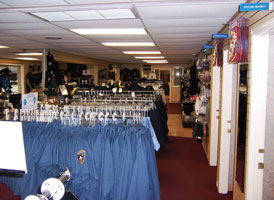 They assigned her a military transport, a two-and-a-half ton truck, and a boat and went to the building. The water was still too high, so they had to abort the mission and make a second effort to get in.
They assigned her a military transport, a two-and-a-half ton truck, and a boat and went to the building. The water was still too high, so they had to abort the mission and make a second effort to get in.
By the second effort, the water was about three-and-a-half feet high, down from the original seven feet. But the waterline it left behind told the story. On the 11th day, the pumps were turned on, removing the water and leaving behind an unbearable mess.
Comboy describes being disheartened, knowing it was pretty much a total loss but no “screaming or hollering.” It was just “wow, this is a disaster.”
Hewlett describes a different reaction. “My opinion was just ‘Take the insurance money and run.’” They did, in fact, get some insurance money and proceeded to pay every one of their employees one to three months’ salary along with sharing the news that they were going out of business.
But Comboy’s fighter spirit won out. While cleaning out the flooded store, the pair created office space on a banquet table in their home dining room and proceeded to locate a trailer in which they could set up shop. Hewlett describes how “everyone was trying to get a FEMA trailer to live in. You had to shop all over the country to find a trailer.” Finally they were able to rent a trailer, which they set up in the store parking lot.
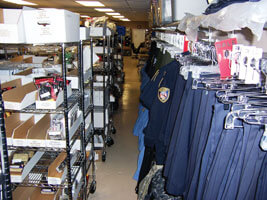 The computers had also suffered severe water damage. Hewlett had carried CDs containing all of their files with him throughout the storm only to discover that they had been backed up incorrectly and were useless. But after 30 years in the business Hewlett’s brain maintained much of the information the computers had lost. Also, thanks to Hewlett being a consistent and thorough email user, he was able to retrieve a great deal of material from the email server. So sitting in their dining room, using a daughter’s college computer, Hewlett began the long task of setting A.P.E. back up.
The computers had also suffered severe water damage. Hewlett had carried CDs containing all of their files with him throughout the storm only to discover that they had been backed up incorrectly and were useless. But after 30 years in the business Hewlett’s brain maintained much of the information the computers had lost. Also, thanks to Hewlett being a consistent and thorough email user, he was able to retrieve a great deal of material from the email server. So sitting in their dining room, using a daughter’s college computer, Hewlett began the long task of setting A.P.E. back up.
Comboy, meanwhile, would head to the store location and sift through the debris looking for whatever could be salvaged. As more and more officers came by looking for equipment, Comboy began to wash what products could be cleaned and passed them on. Customers would tell Comboy what they needed, and she would go home at the end of the day with her handwritten report. Hewlett would try to contact the companies and place the orders. Their back porch became the UPS shipping dock.
For 11 months, business was conducted from a trailer in the parking lot. For six of those months, there was no electricity or phones. Comboy and Hewlett would open the windows of the trailer, conduct business for three or four hours and then pack up and go home.
Mail delivery didn’t start up again for nine months. Part of Comboy’s daily routine was to go to the post office and wait in the lengthy lines.
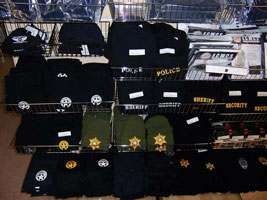 Meanwhile, a pile of flood-soaked inventory six feet high and the complete length of two sides of the building accumulated on the property. But no sooner had it appeared than desperate police officers would be picking through it looking for items they could use.
Meanwhile, a pile of flood-soaked inventory six feet high and the complete length of two sides of the building accumulated on the property. But no sooner had it appeared than desperate police officers would be picking through it looking for items they could use.
Comboy remarks on the attitude of the people around them. “There was such a need, yet people did not complain about their own situation because everyone was in the same situation, and it was kind of like ‘Let’s get on with it and move forward.’”
After 11 months, the rebuilt A.P.E. was ready. All in all, it took less time than many larger businesses in the area. Hewlett is convinced that developing good relationships over the years with both municipal customers and cooperative vendors contributed to that accomplishment.
Moving forward, Hewlett believes their developing web presence is extremely important. Looking at the new website for A.P.E. created through UniformMarket, he proudly points out the New Orleans Fire Department page, which will be followed by the New Orleans Police Department page, and then more and more departments to follow.
Comboy reaffirms her commitment to her city, citing visiting the French Quarter, participating in Mardi Gras and following her beloved Saints as a few of her passions. That and being an award-winning wallpaper installer who specializes in historic restoration. Hewlett’s interests outside of the business lie mostly within the reach of his TV remote control.
But clearly Hewlett and Comboy are fighters who are committed to doing everything they can to serve the hard-working public officers of their community. From rebuilding after the country’s worst man-made disaster to moving forward into the future of technology, A.P.E. will continue to fill the needs of New Orleans with years of experience, vast knowledge and incomparable service.




